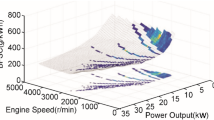Abstract
Recently, to improve vehicle fuel economy, as well as the performance of internal combustion engines, optimized system matching between a vehicle’s drivetrain and engine has become a very important technical issue. For this reason, the need for simulation research on engine and vehicle performance improvement has increased. But in general, since both engine simulation and vehicle simulation require initial engine calibration map input, a simple engine calibration method is required for the efficient configuration of various virtual engine calibration map setups. On this background, in this study, an example of waste gate turbocharger (WGT) cooled — exhaust gas recirculation (EGR) Diesel engine calibration using a test-based mean value engine model is presented as a suitable engine calibration map setting method. Also, the feasibility of an engine calibration model is confirmed through various engine tests. Using the simple model presented here, it is possible for diverse engine operating conditions and engine performance maps to be acquired.
Similar content being viewed by others
Abbreviations
- AF(λ):
-
air-fuel ratio
- Cp :
-
specific heat ratio
- cp :
-
mean piston speed
- D :
-
blade diameter
- Dp :
-
differential pressure
- EGR :
-
EGR rate
- FMEP :
-
friction mean effective pressure
- H :
-
head
- k :
-
coefficients
- ṁ :
-
mass flow rate
- M :
-
compressor inlet Mach number
- N :
-
rotational speed
- PMEP :
-
pumping mean effective pressure
- p :
-
pressure
- Q̇ heat :
-
energy of gas
- Q s :
-
corrected air flow rate
- R:
-
gas constant
- stroke :
-
engine stroke
- T :
-
temperature
- U:
-
blade tip speed
- γ :
-
specific heat ratio
- η :
-
efficiency
- ρ :
-
air density
- ϕ :
-
non-dimensional flow rate
- ψ :
-
dimensionless head parameter
- air:
-
inlet air
- c:
-
compressor
- cool:
-
cooling
- coolant:
-
coolant
- cooler inlet:
-
cooler inlet gas
- cooler outlet:
-
cooler outlet gas
- egr:
-
exhaust gas recirculation
- exmani:
-
exhaust manifold
- i :
-
indicated
- inmani:
-
intake manifold
- max:
-
maximum
- p:
-
polytropic
- r:
-
ratio
- stoi:
-
Stoichiometric
- v :
-
volumetric
- 0:
-
inlet gas
References
Barasa, P., Tian, Y., Hardes, S., Owlia, S., Limaye, P., Bailey, D. and Sehgal, Y. (2016). Virtual engine, controls, and calibration development in automated co-simulation environment. SAE Paper No. 2016-01-0090.
Davis, F. T. and Corripio, A. B. (1974). Dynamic Simulation of Variable Speed Centrifugal Compressors. ISA CPD 74105, 15–24.
Ericksson, L., Lindell, T., Leufven, O. and Thomasson, A. (2012). Scalable component-based modeling for optimizing engines with supercharging, e-boost and turbocompound concepts. SAE Paper No. 2012-01-0713.
Guzzella, L. and Amstutz, A. (1998). Control of diesel engines. IEEE Control Systems 18, 5, 53–71.
Jensen, J. P., Kristensen, A. F., Sorenson, S. C. and Houbak, N. (1991). Mean value modeling of a small turbocharged diesel engine. SAE Paper No. 910070.
Kouremenos, D. A. (2001). Development of a detailed friction model to predict mechanical losses at elevated maximum combustion pressures. SAE Paper No. 2001-01-0333.
Mattarelli, E., Rinaldini, C. A. and Cantore, G. (2015). CFD optimization of a 2-stroke range extender engine. Int. J. Automotive Technology 16, 3, 351–369.
Miklánek, L., Klír, V., Emrich, M. and Pohoelský, L. (2009). Thermal balance method for EGR rate determination usable for real engine with uncooled EGR system. SAE Paper No. 2009-01-1114.
Moraal, P. and Kolmanovsky, I. (1999). Tutbocharger modelling for automotive control applications. SAE Paper No. 1999-01-0908.
Pawar, P., Jose, A., Chaudhari, H. B., Juttu, S., Walke, N. H. and Marathe, N. V. (2017). Virtual engine optimization from design to experimentation. SAE Paper No. 2017-26-0264.
Phlips, P. (2015). Analytical engine and transmission models for vehicle fuel consumption estimation. SAE Paper No. 2015-01-0981.
Rakopoulos, C. D. and Giakoumis, E. G. (2006). Review of thermodynamic diesel engine simulations under transient operating conditions. SAE Paper No. 2006-01-0884.
Schorn, N. A. (2014). The radial turbine for small turbocharger applications: Evoluation and analytical methods for twin-entry turbine turbochargers. SAE Paper No. 2014-01-1647.
Schudeleit, M. and Küçükay, F. (2016). Emission-robust operation of diesel HEV considering transient emissions. Int. J. Automotive Technology 17, 3, 523–533.
Staroselsky, N. and Ladin, L. (1979). Improved surge control for centrifugal compressors. Chemical Engineering, 175–184.
Wachtmeister, G., Höhn, B.-R., Wirth, C., Habersbrunner, G. and Ziegler, A. (2010). Concept for hybrid vehicles with simplified diesel engines. ATZ Worldwide 112, 5, 50–57.
Author information
Authors and Affiliations
Corresponding author
Rights and permissions
About this article
Cite this article
Chung, J.W., Kim, N.H., Kim, D.J. et al. Mean Value WGT Diesel Engine Calibration Model for Effective Simulation Research. Int.J Automot. Technol. 19, 209–220 (2018). https://doi.org/10.1007/s12239-018-0020-5
Received:
Revised:
Accepted:
Published:
Issue Date:
DOI: https://doi.org/10.1007/s12239-018-0020-5




